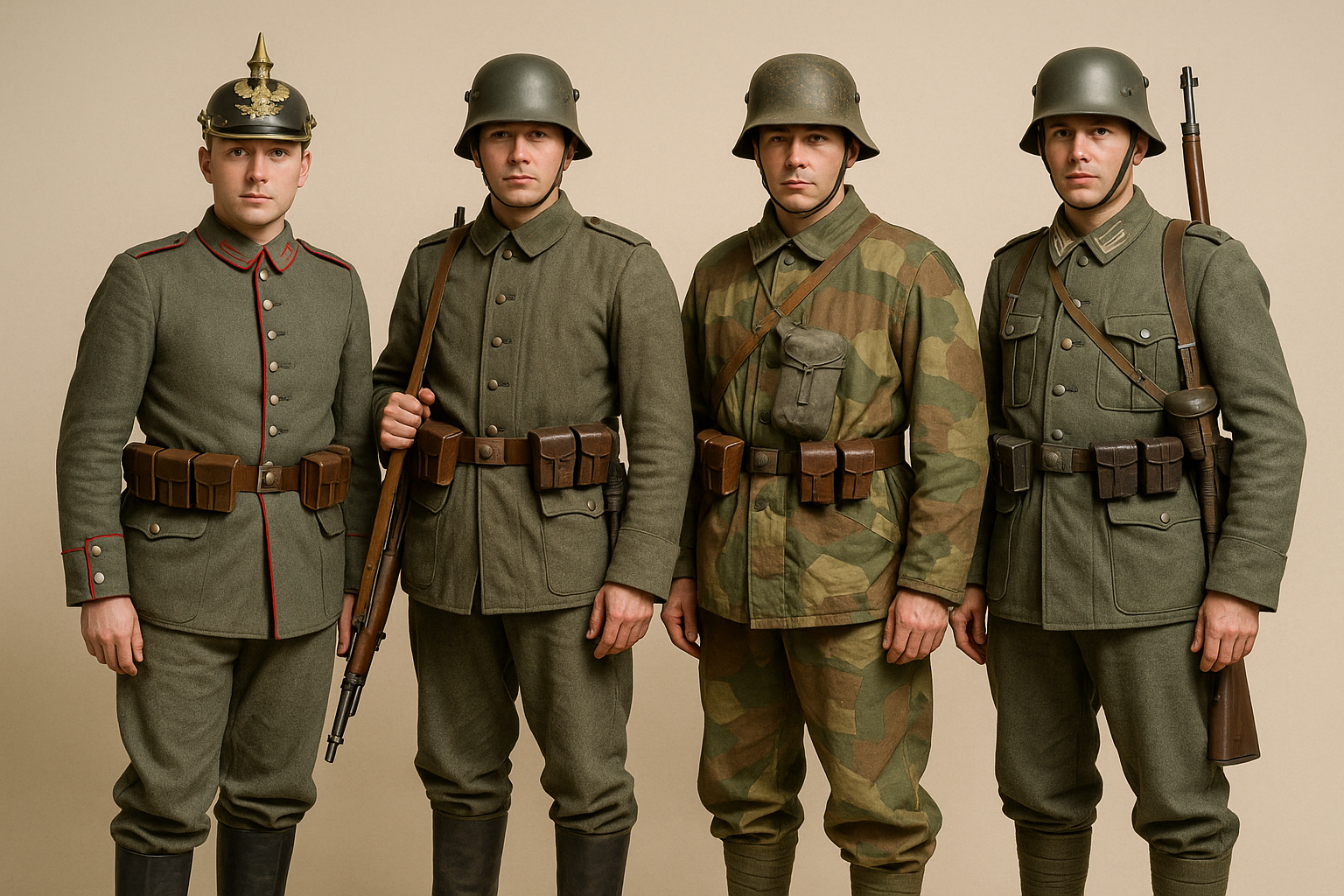
WW1 German Uniform Types: Guide for History Buffs & Collectors
Published on Oct 02, 2025
🪖 WW1 German Uniform Types: A Collector’s Guide for History Enthusiasts
Did you know that over 53% of online searches about WW1 uniforms are informational, while 43% are commercial? This tells us one thing: people are not just buying—they’re learning, researching, and collecting. If you’re one of them, this guide is for you.
From reenactors to historians to hobbyists, understanding the WW1 German uniform is key to appreciating early 20th-century military history. This article explores types, details, and evolution while giving you actionable steps to build or refine your collection.
🔍 Understanding the Purpose: Why Study WW1 German Uniforms?
- Informational intent (53%): People seek to learn the differences, identify ranks, and compare with other nations.
- Commercial intent (43%): They’re buying uniforms or gear for collections, reenactments, or museums.
- Transactional intent (4%): Niche collectors looking to purchase rare or original items.
Whether you're researching for historical writing, building a display, or trying to find accurate gear for reenactments, understanding the WW1 German uniform can bring surprising depth.
🧥 Types of WW1 German Uniforms by Era and Branch
🔰 1. Early-War German Uniforms (1914–1915)
- Colour: Traditional feldgrau (field grey) wool tunics with red piping.
- Pickelhaube helmet: The iconic spiked helmet made of leather.
- Unit distinction: coloured piping and buttons denoted regiment or branch.
✅ Actionable Tip: Early-war uniforms are easier to identify by their bold detailing and higher-quality materials—great for museum-style displays.
🪖 2. Mid-to-Late War Uniforms (1916–1918)
- Simpler tunics due to material shortages.
- Spike helmets were replaced with the M1916 Stahlhelm (steel helmet).
- Shoulder boards indicated rank and unit.
- Use of camouflage smocks and gas mask gear became common.
✅ Actionable Tip: Look for M1915 or M1916 tunics with sewn-in shoulder boards—ideal for authenticity.
⚠️ Pitfall to Avoid:
Don’t mistake WW2 field gray shades with WW1 versions. WW2 German uniforms are often darker and more refined in cut.
🏷️ Rank and Unit-Specific Details in WW1 German Uniforms
🎖️ Officer Uniforms
- Made from higher-quality wool, often tailored.
- Worn with swords or pistols, leather boots, and officer belts.
- Cap insignia included state-specific cockades.
🪖 Enlisted Men’s Uniforms
- Simpler construction.
- Limited insignia, but brass buttons, shoulder straps, and cap details still varied.
🌍 Comparing WW1 German Uniforms with Other Nations
Understanding uniform types across nations enhances both collecting and historical accuracy.
🇺🇸 WW1 US Uniform vs WW1 German Uniform
Feature WW1 German Uniform WW1 US Uniform
Color Feldgrau (gray-green) Olive drab
Helmet Pickelhaube/Stahlhelm M1917 Brodie helmet
Pockets, Box pleats, Slant-cut or patch pockets
Cut longer tunics. Shorter jackets
✅ Why it matters: Reenactors often mix these up. Knowing the difference improves historical accuracy.
🇬🇧 WW2 English Uniforms vs WW1 German Uniforms
- WW2 English uniforms had battle dress blouses, short wool tunics, and khaki colours.
- The helmet was a major distinction—a flat-topped Brodie helmet for British troops, compared to the Stahlhelm.
✅ Actionable Tip: Uniforms from WW2 English infantry are often mistakenly labelled as WW1-era—always verify production dates and features.
🧭 Evolution: From WW1 to East Germany Uniforms
Many wonder how uniforms changed after WW1, especially into the Cold War.
- Weimar Republic era (1919–1933): Used WW1 surplus with minor changes.
- WW2 uniforms: sleeker, more efficient design, higher-quality stitching.
- East Germany uniform (GDR NVA): Post-WW2 Soviet-influenced style; greyish-green colour, peaked caps, and minimal ornamentation.
✅ Pro Tip: East Germany uniforms are cheaper to collect and still give a great insight into Cold War military fashion.
📦 Actionable Steps for Collectors of WW1 German Uniforms
🎯 1. Define Your Focus
- Infantry, cavalry, or medical units?
- Officer or enlisted gear?
🛠️ 2. Start with Replicas (If You're New)
- Cost-effective and safe to wear.
- Avoid expensive mistakes early on.
🧾 3. Learn the Insignia
- Use uniform guides, forums, or museum catalogues.
- Rank insignia is often confused between the WW1 and WW2 eras.
🏷️ 4. Verify Authenticity Before Buying
- Check stitching, wear patterns, and label types.
- Use reputable auction sites or consult historians.
❌ Common Pitfalls When Dealing with WW1 German Uniforms
- Buying mislabelled WW2 gear as WW1.
- Confusing replicas with originals—some are near-identical.
- Ignoring regional variations like Bavarian vs Prussian insignia.
- Assuming East Germany uniforms are WW2 German army surplus.
📈 Current Trends in Uniform Collecting (2025)
- 🔥 Increased interest in lesser-known units, like German colonial troops.
- 💬 Growing online communities on Reddit and military forums.
- 📱 Use of AI tools and apps to verify uniform features via image scans.
- 🧵 DIY reenactor builds using authentic material suppliers.
🧠 Helpful Resources for Beginners
- Books: “World War I German Army Uniforms and Equipment” by Stephen Bull
- Websites:
- German-Militaria.com
- IMA-USA.com
- Communities:
- r/MilitaryCollecting on Reddit
- Wehrmacht-Awards Forum
🏁 Conclusion: Why the WW1 German Uniform Still Matters
The WW1 German uniform represents more than military attire—it tells a story of industrial change, political evolution, and individual soldier experiences. Whether you’re a beginner collector, a reenactor, or a military historian, understanding the nuances of these uniforms opens doors to deeper insight.
✅ Don’t forget to explore comparisons like the WW1 US uniform or how WW2 English uniforms evolved. Even diving into East Germany uniforms helps complete the historical picture.
